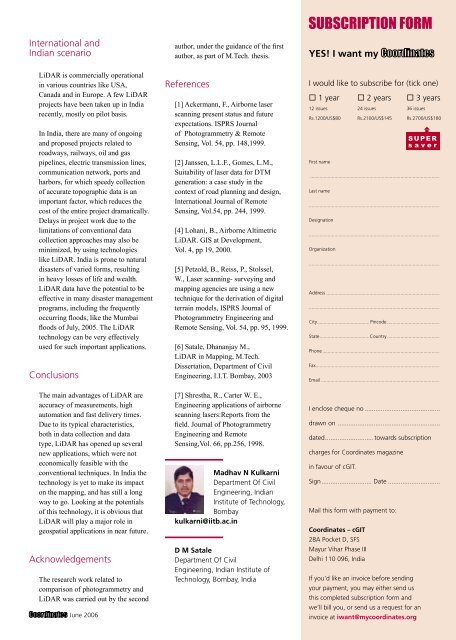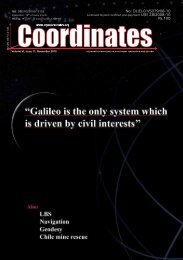Download - Coordinates
Download - Coordinates
Download - Coordinates
Create successful ePaper yourself
Turn your PDF publications into a flip-book with our unique Google optimized e-Paper software.
International and<br />
Indian scenario<br />
LiDAR is commercially operational<br />
in various countries like USA,<br />
Canada and in Europe. A few LiDAR<br />
projects have been taken up in India<br />
recently, mostly on pilot basis.<br />
In India, there are many of ongoing<br />
and proposed projects related to<br />
roadways, railways, oil and gas<br />
pipelines, electric transmission lines,<br />
communication network, ports and<br />
harbors, for which speedy collection<br />
of accurate topographic data is an<br />
important factor, which reduces the<br />
cost of the entire project dramatically.<br />
Delays in project work due to the<br />
limitations of conventional data<br />
collection approaches may also be<br />
minimized, by using technologies<br />
like LiDAR. India is prone to natural<br />
disasters of varied forms, resulting<br />
in heavy losses of life and wealth.<br />
LiDAR data have the potential to be<br />
effective in many disaster management<br />
programs, including the frequently<br />
occurring floods, like the Mumbai<br />
floods of July, 2005. The LiDAR<br />
technology can be very effectively<br />
used for such important applications.<br />
Conclusions<br />
The main advantages of LiDAR are<br />
accuracy of measurements, high<br />
automation and fast delivery times.<br />
Due to its typical characteristics,<br />
both in data collection and data<br />
type, LiDAR has opened up several<br />
new applications, which were not<br />
economically feasible with the<br />
conventional techniques. In India the<br />
technology is yet to make its impact<br />
on the mapping, and has still a long<br />
way to go. Looking at the potentials<br />
of this technology, it is obvious that<br />
LiDAR will play a major role in<br />
geospatial applications in near future.<br />
Acknowledgements<br />
author, under the guidance of the first<br />
author, as part of M.Tech. thesis.<br />
References<br />
[1] Ackermann, F., Airborne laser<br />
scanning present status and future<br />
expectations. ISPRS Journal<br />
of Photogrammetry & Remote<br />
Sensing, Vol. 54, pp. 148,1999.<br />
[2] Janssen, L.L.F., Gomes, L.M.,<br />
Suitability of laser data for DTM<br />
generation: a case study in the<br />
context of road planning and design,<br />
International Journal of Remote<br />
Sensing, Vol.54, pp. 244, 1999.<br />
[4] Lohani, B., Airborne Altimetric<br />
LiDAR. GIS at Development,<br />
Vol. 4, pp 19, 2000.<br />
[5] Petzold, B., Reiss, P., Stolssel,<br />
W., Laser scanning- surveying and<br />
mapping agencies are using a new<br />
technique for the derivation of digital<br />
terrain models, ISPRS Journal of<br />
Photogrammetry Engineering and<br />
Remote Sensing, Vol. 54, pp. 95, 1999.<br />
[6] Satale, Dhananjay M.,<br />
LiDAR in Mapping, M.Tech.<br />
Dissertation, Department of Civil<br />
Engineering, I.I.T. Bombay, 2003<br />
[7] Shrestha, R., Carter W. E.,<br />
Engineering applications of airborne<br />
scanning lasers:Reports from the<br />
field. Journal of Photogrammetry<br />
Engineering and Remote<br />
Sensing,Vol. 66, pp.256, 1998.<br />
YES! I want my<br />
I would like to subscribe for (tick one)<br />
1 year 2 years 3 years<br />
12 issues 24 issues 36 issues<br />
Rs.1200/US$80 Rs.2100/US$145 Rs.2700/US$180<br />
First name<br />
................................................................................................<br />
Last name<br />
.................................................................................................<br />
Designation<br />
.................................................................................................<br />
Organization<br />
.................................................................................................<br />
Address ....................................................................................<br />
.................................................................................................<br />
City ....................................... Pincode .......................................<br />
State .....................................Country .......................................<br />
Phone .......................................................................................<br />
Fax ............................................................................................<br />
Email ........................................................................................<br />
I enclose cheque no ..........................................<br />
drawn on .........................................................<br />
dated ...........................towards subscription<br />
charges for <strong>Coordinates</strong> magazine<br />
in favour of cGIT.<br />
Madhav N Kulkarni<br />
Department Of Civil<br />
Engineering, Indian<br />
Institute of Technology,<br />
Sign ............................ Date .............................<br />
Bombay<br />
kulkarni@iitb.ac.in<br />
Mail this form with payment to:<br />
<strong>Coordinates</strong> – cGIT<br />
28A Pocket D, SFS<br />
D M Satale<br />
Mayur Vihar Phase III<br />
Department Of Civil<br />
Engineering, Indian Institute of<br />
Delhi 110 096, India<br />
The research work related to<br />
Technology, Bombay, India<br />
If you’d like an invoice before sending<br />
comparison of photogrammetry and<br />
your payment, you may either send us<br />
LiDAR was carried out by the second<br />
this completed subscription form and<br />
we’ll bill you, or send us a request for an<br />
June 2006 invoice at iwant@mycoordinates.org 33

















